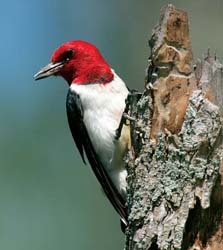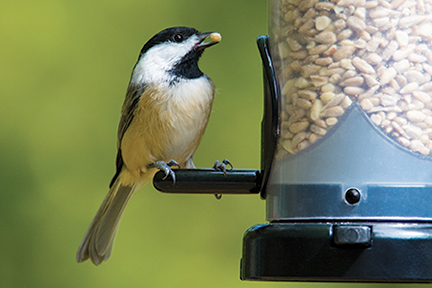
Fun Facts About Red Headed Woodpeckers
- The gorgeous Red-headed Woodpecker is so boldly patterned it’s been called a “flying checkerboard,” with an entirely crimson head, a snow-white body, and half white, half inky black wings. These birds don’t act quite like most other woodpeckers: they’re adept at catching insects in the air, and they eat lots of acorns and beech nuts, often hiding away extra food in tree crevices for later. This magnificent species has declined severely in the past half-century because of habitat loss and changes to its food supply .
- The Red-headed Woodpecker is one of only four North American woodpeckers known to store food, and it is the only one known to cover the stored food with wood or bark. It hides insects and seeds in cracks in wood, under bark, in fenceposts, and under roof shingles. Grasshoppers are regularly stored alive, but wedged into crevices so tightly that they cannot escape.
- Red-headed Woodpeckers eat insects, fruits, and seeds. Overall, they eat about one-third animal material (mostly insects) and two-thirds plant material. Their insect diet includes beetles, cicadas, midges, honeybees, and grasshoppers. They are one of the most skillful flycatchers among the North American woodpeckers. Red-headed Woodpeckers eat seeds, nuts, corn, berries and other fruits.
- The male selects a site for a nest hole; the female may tap around it, possibly to signal her approval. They nest in dead trees or dead parts of live trees—including pines, maples, birches, cottonwoods, and oaks—in fields or open forests. They often use snags that have lost most of their bark, creating a smooth surface that may deter snakes. They occasionally use natural cavities. Unlike many woodpeckers, Red-headed Woodpeckers often reuse a nest cavity several years in a row. Both partners help build the nest, though the male does most of the excavation. He often starts with a crack in the wood, digging out a gourd-shaped cavity usually in 12–17 days. The cavity is about 3–6 inches across and 8–16 inches deep. The entrance hole is about 2 inches in diameter
- The oldest Red-headed Woodpecker on record was banded in 1926 in Michigan and lived to be at least 9 years, 11 months old.

